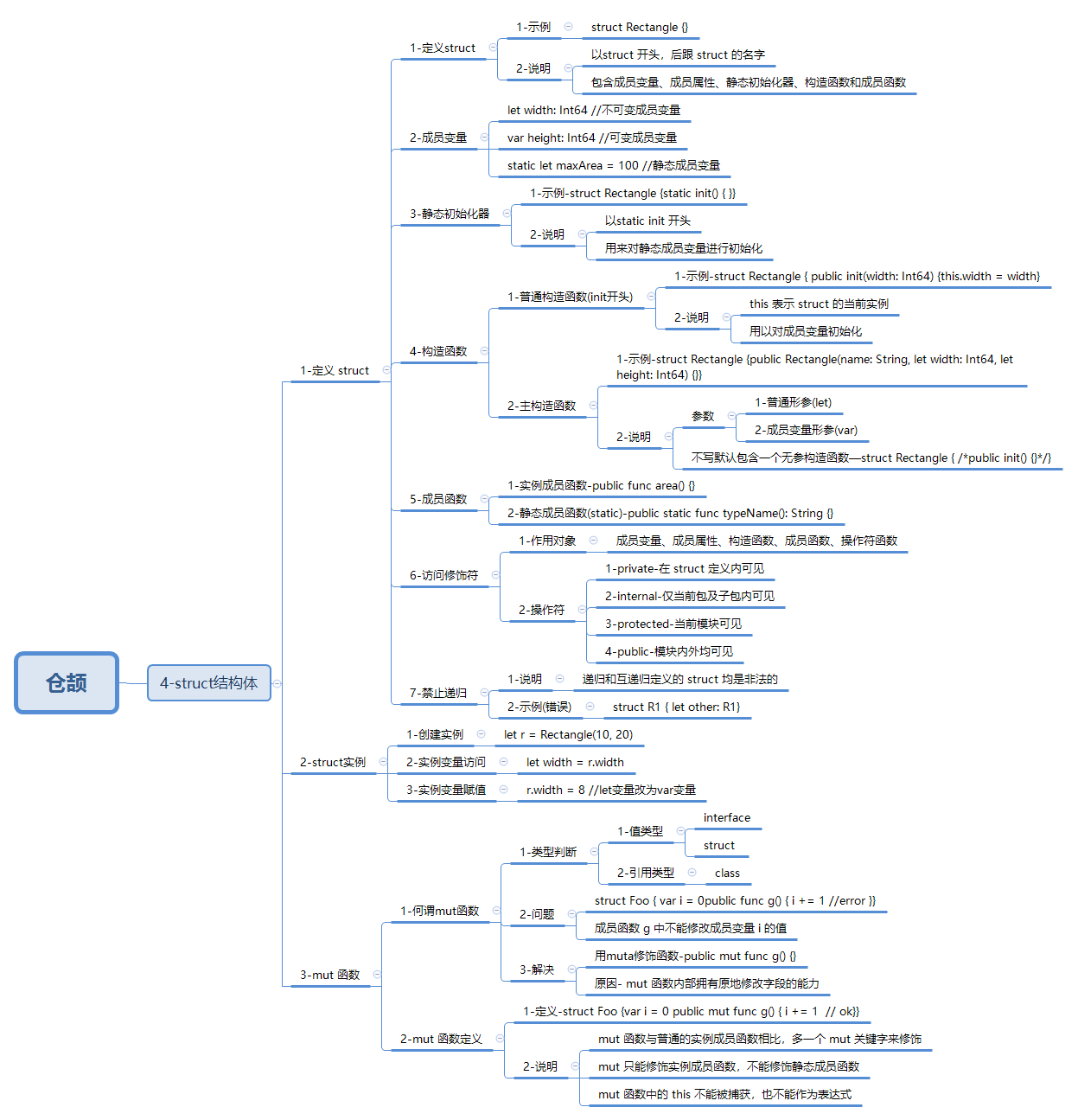一 概述
- 定义struct类型
- 创建struct实例
- mut函数
二 定义struct类型
2.1 struct定义
1
2
3
4
5
6
7
8
9
10
11
12
13
| struct Rectangle {
let width: Int64
let height: Int64
public init(width: Int64, height: Int64) {
this.width = width
this.height = height
}
public func area() {
width * height
}
}
|
说明:
- struct 类型的定义以关键字 struct 开头,后跟 struct 的名字,接着是定义在一对花括号中的 struct 定义体
- struct 定义体中可以定义一系列的成员变量、成员属性(参见属性)、静态初始化器、构造函数和成员函数。
2.2 struct 成员变量
1
2
3
4
5
| struct Rectangle {
let width: Int64
var height: Int64
static let maxArea = 100
}
|
说明:
- width:不可变成员变量
- height:可变成员变量
- maxArea:静态成员变量
2.3 struct 静态初始化器( static init )
1
2
3
4
5
6
| struct Rectangle {
static let degree: Int64
static init() {
degree = 180
}
}
|
说明:
- 静态初始化器以关键字组合 static init 开头
- 用来对静态成员变量进行初始化
2.4 struct 构造函数
1-普通构造函数(init开头)
1
2
3
4
5
6
7
8
9
10
11
12
13
14
15
16
17
18
19
| struct Rectangle {
let width: Int64
let height: Int64
public init(width: Int64) {
this.width = width
this.height = width
}
public init(width: Int64, height: Int64) { // Ok: overloading
this.width = width
this.height = height
}
public init(height: Int64) { // Error, redefinition
this.width = height
this.height = height
}
}
|
2-主构造函数
1
2
3
| struct Rectangle {
public Rectangle(name: String, let width: Int64, let height: Int64) {}
}
|
说明:
- 主构造函数的参数列表中也可以定义普通形参(name)
- struct 中不存在自定义构造函数(包括主构造函数),并且所有实例成员变量都有初始值,则会自动为其生成一个无参构造函数
2.5 struct 成员函数
1
2
3
4
5
6
7
8
9
10
11
12
| struct Rectangle {
let width: Int64 = 10
let height: Int64 = 20
public func area() {
this.width * this.height
}
public static func typeName(): String {
"Rectangle"
}
}
|
说明:
- area 是实例成员函数,typeName 是静态成员函数
- 实例成员函数中可以通过 this 访问实例成员变量
2.6 struct 成员的访问修饰符
| No |
修饰符 |
说明 |
| 1 |
private |
在 struct 定义内可见 |
| 2 |
internal |
仅当前包及子包(包括子包的子包,详见包章节)内可见 |
| 3 |
protected |
当前模块(详见包章节)可见 |
| 4 |
public |
模块内外均可见 |
2.7 禁止递归 struct
1
2
3
4
5
6
7
8
9
| struct R1 { // Error, 'R1' recursively references itself
let other: R1
}
struct R2 { // Error, 'R2' and 'R3' are mutually recursive
let other: R3
}
struct R3 { // Error, 'R2' and 'R3' are mutually recursive
let other: R2
}
|
说明:递归和互递归定义的 struct 均是非法的
三 创建struct实例
3.1 创建实例
1
| let r = Rectangle(10, 20)
|
3.2 实例变量访问
1
2
3
| let width = r.width // width = 10
let height = r.height // height = 20
let a = r.area() // a = 200
|
3.3 实例变量赋值(let变量改为var变量)
1
2
3
4
5
6
7
8
9
10
11
12
13
14
15
16
17
18
19
20
| struct Rectangle {
public var width: Int64
public var height: Int64
public init(width: Int64, height: Int64) {
this.width = width
this.height = height
}
public func area() {
width * height
}
}
main() {
var r = Rectangle(10, 20) // r.width = 10, r.height = 20
r.width = 8 // r.width = 8
r.height = 24 // r.height = 24
let a = r.area() // a = 192
}
|
四 mut 函数
4.1 何谓mut函数
1
2
3
4
5
6
7
| struct Foo {
var i = 0
public func g() {
i += 1 // Error, the value of a instance
}
}
|
说明:
- struct 类型是值类型,其实例成员函数无法修改实例本身
- 成员函数 g 中不能修改成员变量 i 的值,会出错
- mut 函数是一种可以修改 struct 实例本身的特殊的实例成员函数,在 mut 函数内部拥有原地修改字段的能力
4.2 mut 函数定义
1
2
3
4
5
6
7
| struct Foo {
var i = 0
public mut func g() {
i += 1 // ok
}
}
|
说明:
- 增加 mut 修饰符之后,即可在函数体内修改成员变量 i 的值
- mut 只能修饰实例成员函数,不能修饰静态成员函数。
- mut 函数中的 this 不能被捕获,也不能作为表达式。不能在 mut 函数中对 struct 的实例成员变量进行捕获
五 思维导图

六 参考
